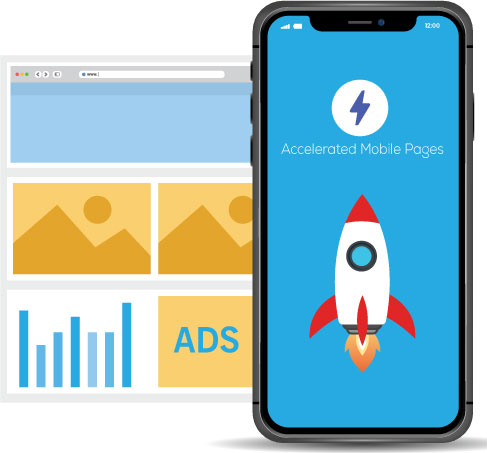
Known as AMPHTML ads, these are a faster, lighter, and more secure method for digital publishers looking to serve website ads. Created according to special AMPHTML ad specifications, as opposed to hypertext markup or HTML language, AMP ads rely on the AMP Open Source project and can be served on both AMP and non-AMP pages.
AMP pages have turned out to be quite popular, adopted by a majority of websites online, including the Washington Post, to ensure a faster, more efficient mobile web experience. Leveraged by digital publishers to increase site performance, these can help the former get maximum ROI.
What Are AMP Ads

An acronym for Accelerated Mobile Pages, this concept was launched in February 2016, with an aim to help mobile website content load immediately. Google was the main sponsor, along with Twitter, Bing, Baidu, and Pinterest as well as others. Aiming to minimize data to 8 times smaller than the mobile page size, Google’s AMP might result in an increase in revenue. Thus, faster, lighter, and capable of loading as fast as the rest of the AMP page, these ads, created by AMP’s smart open-source components, are devoid of useless JavaScript (JS), ensuring a seamless advertising experience. Validation before display protects them from malware. Developers need to build them only once and they can be used freely on both AMP and non-AMP pages.
How Do AMP Ads Work
Similar to standard HTML ads, there are 3 steps to AMP ads.
- Publishers use an ad slot to insert an ad, through the amp-ad tag, further defining the SSPs or ad networks they prefer.
- A piece of JS code controlling the implementation of AMP elements and managing resource loading, or AMP runtime, further sends an ad request to a network to retrieve said ad.
- The AMPHTML ad is sent by the ad network, and AMP runtime starts before the ad rendering.
Usually, ad networks have the ability of serving AMPHTML ad creatives, with each creative validated and signed via the Fast Fetch mechanism, the process being the same for AMP and non-AMP pages. The Fast Fetch mechanism ensures that AMP ads are fast (2.7 seconds faster, to be precise), as they’re fetched asynchronously, rendered only when users might see them. As ads and their responses are separated, ad requests are entertained during the early stages of a page’s life cycle.
AMP Video Ads
Being heavy, videos can slow site loading time, affecting end-user experience. AMP videos can help monetization without hampering speed. There are 16 video players, like DailyMotion, Brightcove, amongst others. Apart from these, custom components like <amp-iframe> can be used to integrate your existing player. Video ads boast a higher completion rate on AMP pages, appear more frequently on traditional web pages, and are a huge source of ad revenue. Instream video ads can be served by publishers using the <amp-ima-video) component, which works as a standard video player with functions like docking and auto-play on scroll. Publishers who don’t have video content can also deliver out-stream ads, courtesy of the <amp-ad> component.
What Are The Benefits of AMP Ads
Speed
Faster than regular ads as they are requested earlier in the web page’s life cycle, AMPHTML ads help page rendering and creating selection happen parallelly. The omission of unnecessary elements makes these ads good performers.
Page Latency
Publishers often put up with high page latency due to slow-loading ads. AMPHTML ads are rendered immediately, reducing this significantly.
Performance
AMP runtime is tuned to work according to mobile resources. For instance, when not in view, AMPHTML ads with animations will not play.
Size and Viewability
These ads are low on browser resource consumption due to their light size. They load faster, making them more viewable.
Safe
AMP validates each ad creative before users see it, making AMPHTML ads fraud safe.
Customizable
Working across devices on both AMP and non-AMP web pages, AMPHTML ads allow publishers to put down different strategies for ad loading, by changing one line of code.
Amount of Ads
Publisher’s HTML page and AMP pages should be the same, content-wise. However, AMP pages can have more ads than the original HTML page, giving publishers more flexibility and control.
Free, With Good ROI
An open-source project, AMP’s product suite, and resources are free. AMPHTML ads have a higher number of viewable impressions, generating more revenue per day for publishers.
AMP Ads Also Have Their Disadvantages
Here are some cons to running AMP ads.
- Say goodbye to any fancy design elements, because UX is very basic.
- There will be random errors and warnings in Google’s Search Console. Fix them, whether they appear to resolve themselves or not. That means constantly working on the AMP platform.
- Depending on the website size, your workload might be more because you’ll need to maintain two identical websites.
- Using Analytics, Ads, or DoubleClick to track data from AMP pages is tricky.
Does AMP add Value

AMP allows you to create your own custom design but is not just a simple code strip. As Google’s servers do a small pre-render of your website, you cannot speed up your site to be faster than the caches themselves. AMP could help with increasing page results, but knowledge of how to track the data served from Google’s servers is tricky. AMP has created a plugin, to help you create your own AMP pages, design, etc, according to the AMP project guidelines.
A lot of ad platforms, networks, and agencies are on-board with AMP, but there has been some criticism regarding its nature. AMP is a threat to the open web, alleging a few, courtesy of its supposed ‘rankings favoritism’. This is because Google always lets its own exchange win, despite submitting lower bids, courtesy of its fierce anti-competitive practices. Firebolt, Cloudflare, offers similar benefits, but then, any product/platform needs sufficient research before you implement it.
Results of AMP on Revenue
Since we have covered the advantages and disadvantages of AMP and the details of its implementation, it’s time to focus on the effect of AMP on Ad Revenue. While you certainly get better traffic from Google, including mobile search, ad revenue might suffer a little. For monetizing AMP pages, Ad Exchange and AdSense are sufficient, with other networks not optimized to work with AMP.
Conclusion
AMPs are very beneficial for publishers who want to boost page speed and give their subscribers faster ads. Creating an AMP ad is as easy as creating a regular ad, with the former increasing revenue significantly for advertisers. What’s more. Google is constantly innovating functionality, which makes working with AMP to boost ad performance a lucrative option.
At the end of the day, it’s all about providing a pleasant and memorable user experience. With more users going mobile, AMP ads might be the way forward. Read our blog to find out the right way of striking the fine balance between ads and user experience. Also learn how to optimize your ads so they remain non-intrusive, helping you retain your audience.
